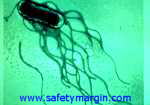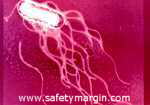 |
Auto | Child | Food | Home | Contact Us | CoolDotComs.com™ | Software
 Food Safety Food Safety
    
Salmonella enteritidis
Infection (Salmonella)
 
Egg-associated salmonellosis is an important public
health problem in the United States and several European
countries. Salmonella
enteritidis, a bacterium, can be
inside perfectly normal-appearing eggs, and if the eggs
are eaten raw or undercooked, the bacterium can cause
illness. During the 1980s, illness related to
contaminated eggs occurred most frequently in the
northeastern United States, but now illness caused by
Salmonella enteritidis is increasing in other parts of
the country as well. Consumers should be aware of the
disease and learn how to minimize the chances of becoming
ill.
Salmonella
enteritidis Infection
A person infected with the Salmonella enteritidis
bacterium usually has fever, abdominal cramps, and
diarrhea beginning 12 to 72 hours after consuming a
contaminated food or beverage. The illness usually lasts
4 to 7 days, and most persons recover without antibiotic
treatment. However, the diarrhea can be severe, and the
person may be ill enough to require hospitalization.
The elderly, infants, and those with impaired immune
systems may have a more severe illness. In these
patients, the infection may spread from the intestines to
the blood stream, and then to other body sites and can
cause death unless the person is treated promptly with
antibiotics.
How Eggs Become
Contaminated
Unlike eggborne salmonellosis of past decades, the
current epidemic is due to intact and disinfected grade A
eggs. Salmonella enteritidis silently infects the ovaries
of healthy appearing hens and contaminates the eggs
before the shells are formed.
Most types of Salmonella live in the intestinal tracts of
animals and birds and are transmitted to humans by
contaminated foods of animal origin. Stringent procedures
for cleaning and inspecting eggs were implemented in the
1970s and have made salmonellosis caused by external
fecal contamination of egg shells extremely rare.
However, unlike eggborne salmonellosis of past decades,
the current epidemic is due to intact and disinfected
grade A eggs. The reason for this is that Salmonella
enteritidis silently infects the ovaries of healthy
appearing hens and contaminates the eggs before the
shells are formed. Although most infected hens have been
found in the northeastern United States, the infection
also occurs in hens in other areas of the country. In the
Northeast, approximately one in 10,000 eggs may be
internally contaminated. In other parts of the United
States, contaminated eggs appear less common. Only a
small number of hens seem to be infected at any given
time, and an infected hen can lay many normal eggs while
only occasionally laying an egg contaminated with the
Salmonella bacterium.
Who Can Be
Infected?
The elderly, infants, and persons with impaired immune
systems are at increased risk for serious illness.
Healthy adults and children are at risk for
egg-associated salmonellosis, but the elderly, infants,
and persons with impaired immune systems are at increased
risk for serious illness. In these persons, a relatively
small number of Salmonella bacteria can cause severe
illness. Most of the deaths caused by Salmonella
enteritidis have occurred among the elderly in nursing
homes. Egg-containing dishes prepared for any of these
high-risk persons in hospitals, in nursing homes, in
restaurants, or at home should be thoroughly cooked and
served promptly.
What is the
Risk?
In affected parts of the United States, we estimate that
one in 50 average consumers could be exposed to a
contaminated egg each year. If that egg is thoroughly
cooked, the Salmonella organisms will be destroyed and
will not make the person sick. Many dishes made in
restaurants or commercial or institutional kitchens,
however, are made from pooled eggs. If 500 eggs are
pooled, one batch in 20 will be contaminated and everyone
who eats eggs from that batch is at risk. A healthy
person's risk for infection by Salmonella enteritidis is
low, even in the northeastern United States, if
individually prepared eggs are properly cooked, or foods
are made from pasteurized eggs.
What You Can Do
to Reduce Risk
Eggs, like meat, poultry, milk, and other foods, are safe
when handled properly. Shell eggs are safest when stored
in the refrigerator, individually and thoroughly cooked,
and promptly consumed. The larger the number of
Salmonella present in the egg, the more likely it is to
cause illness.
Keeping eggs adequately refrigerated prevents any
Salmonella present in the eggs from growing to higher
numbers, so eggs should be held refrigerated until they
are needed. Cooking reduces the number
of bacteria present in an egg; however, an egg with a
runny yolk still poses a greater risk than a completely
cooked egg. Undercooked egg whites and yolks have
been associated with outbreaks of Salmonella enteritidis
infections. Both should be consumed promptly and
not be held in the temperature range of 40 to 140 for
more than 2 hours.
Reducing The
Risk Salmonella Enteritidis Infection
 Keep eggs
refrigerated. Keep eggs
refrigerated.
 Discard cracked or
dirty eggs. Discard cracked or
dirty eggs.
 Wash hands and cooking
utensils with soap and water after contact with raw eggs. Wash hands and cooking
utensils with soap and water after contact with raw eggs.
 Eat eggs promptly after
cooking. Do not keep eggs warm for more than 2 hours. Eat eggs promptly after
cooking. Do not keep eggs warm for more than 2 hours.
 Refrigerate unused or
leftover egg-containing foods. Refrigerate unused or
leftover egg-containing foods.
 Avoid eating raw eggs
(as in homemade ice cream or eggnog). Commercially
manufactured ice cream and eggnog are made with
pasteurized eggs and have not been linked with Salmonella
enteritidis infections. Avoid eating raw eggs
(as in homemade ice cream or eggnog). Commercially
manufactured ice cream and eggnog are made with
pasteurized eggs and have not been linked with Salmonella
enteritidis infections.
 Avoid restaurant dishes
made with raw or undercooked, unpasteurized eggs. Avoid restaurant dishes
made with raw or undercooked, unpasteurized eggs.
 Restaurants should use
pasteurized eggs in any recipe (such as Hollandaise sauce
or caesar salad dressing) that calls for pooling of raw
eggs. Restaurants should use
pasteurized eggs in any recipe (such as Hollandaise sauce
or caesar salad dressing) that calls for pooling of raw
eggs.
What Else is
Being Done?
Government agencies and the egg industry have taken steps
to reduce Salmonella enteritidis outbreaks. These steps
include the difficult task of identifying and removing
infected flocks from the egg supply and increasing
quality assurance and sanitation measures.
The Centers for Disease Control has advised state health
departments, hospitals, and nursing homes of specific
measures to reduce Salmonella enteritidis infection. Some
states now require refrigeration of eggs from the
producer to the consumer. The U.S. Department of
Agriculture is testing the breeder flocks that produce
egg-laying chickens to ensure that they are free of
Salmonella enteritidis. Eggs from known infected
commercial flocks will be pasteurized instead of being
sold as grade A shell eggs. The U.S. Food and Drug
Administration has issued guidelines for handling eggs in
retail food establishments and will be monitoring
infection in laying hens.
Research by these agencies and the egg industry is
addressing the many unanswered questions about Salmonella
enteritidis, the infections in hens,and contaminated
eggs. Informed consumers, food-service establishments,
and public and private organizations are working together
to reduce, and eventually eliminate, disease caused by
this infectious organism.
    
Documents
and links provided are for informational purposes only.
The entire risk of the use of, or the results from the
use of this information remains with you. By accessing
this web site, you agree to abide by its Terms of Use.
SafetyMargin.com
is a  domain! domain!
Want to Advertise? Contact us.
|
|
